Bonanza Offer FLAT 20% off & $20 sign up bonus Order Now
Marketing is defined as the activity and processes that are undertaken by the business organizations in order to create, communicate, deliver and exchange the offerings that have value for the clients, customers, partners and society at large (Kotler and Armstrong, 2006).
Thus taking into consideration the above aspects, the report emphasizes upon defining the customers’ needs, wants and demands in the context of BMW. It also emphasizes upon orientation exhibited by BMW towards the market place, the competitive issues that are faced by BMW and its segmentation, targeting and positioning strategies.
Bavarian Motor Works (BMW) is the German-based company and is one of most respected automakers renowned mainly for crafting luxury cars and SUVs aimed at offering superior level of comfort and enjoyment to its customers (Bmw, 2014). The company is the most successful premium car brand in the world and major markets are Italy, USA and Germany. However it also operates in other countries and the figure presented below exhibits its sales figure in different countries across the globe.
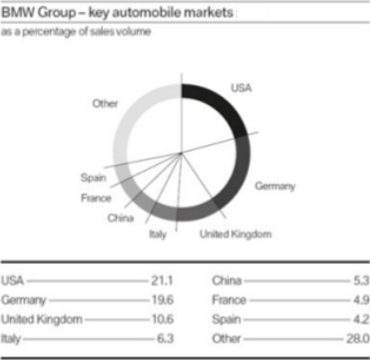
[Source: Bmw, 2014]
The needs of human beings can be defined as a state of felt deprivation. Moreover, where some are basic physical, social and individual needs, some needs are created by the marketers.
The wants can be referred to as a form of human needs that are shaped by the personality and the culture of the individual (Karunakaran, 2008). The wants are shaped by the society and by the marketing programs and these wants when backed by purchasing power, it becomes the demand of the individual.
In relation to BMW cars, it can be said that the need of the BMW customers include the need to travel and convenience. The Wants can be related to factors like luxury, quality, comfort, style, prestige and status and demand of BME customers is obvious that they possess the purchasing power to satisfy their needs and wants
Thus from the above definitions, it can be said that needs, wants and demands tend to differ from one individual to another and it is highly influenced by the factors like the personality, attitude, perception, culture, beliefs, income, class and society (Sheehan, 2011). Thus there are different attitudes that are related to different types of customers mainly because of the fact that the feelings, cognition and response dispositions of the customers are organized into a set of patterned emotional reactions. Moreover there are subjective and objective variables that are related to the car buying decisions of the customers (Engel et al., 2010). The objective categories include the following:
The subjective categories include the following:
So relating the above facts with the luxury car brands like BMW, it can be said that the luxury cars are looked upon as a part of the owner’s life i.e. it should be capable of facilitating its owner the practicability in terms of both functionality and perceptual point of view (Engel et al.,. 2007). This is the only reason why BMW has been successful in dominating the luxury car segment of the market globally. The manufacturer provides everything in their product that facilitates the owners with a sense of prestige and status wherever he travels with his BMW car (Wänke, Bohner and Jurkowitsch, 2007).
Moreover, the society of Motor manufacturers and Traders Limited (SMMT) has classified the cars in segments like lower medium, upper medium, mini, luxury saloon, executive, dual purpose, specialist sports and multipurpose vehicles. Among the above segments, it is observed that there exists a separate segment called ‘luxury saloon’. So in this context, it is observed that most of the luxury automobile manufacturers like BMW not only aim at producing saloons but also offers dual purpose, specialist sports and MPV cars (Johansson-Stenman and Martinsson, 2006). For example, BMW positions its products in different segments as follows:
| Segment | BMW Cars |
| Lower medium | 3 series compact |
| Upper medium | 3 series |
| Executive | 5 series |
| Dual purpose | 5 series |
| Luxury Saloon | 7 series |
| Specialist sports | 8 series |
Thus from the above discussions, it becomes obvious that BMW vehicles sell well to the consumers who prioritizes the standards for luxury, performance and quality since the company efficiently builds these attributes into its automobiles. The company mainly focuses upon the premium segment of the market and the process of consistently defining the high-end brand identification facilitates the company in achieving success. The trendsetting products of the company ranging from the series 3 to series 8 are aimed at affluent and premium customers.
With changing market place, the ways in which the business deals with the marketplace has also changed. Thus the orientation of the business towards the marketplace mainly deals with the concepts that are applied by the company while targeting the market (Moschis, 2006). So, in general there are five different orientations that are adopted by the company towards the marketplace and it can be illustrated with the help of the following figure:
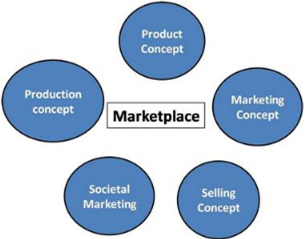
[Source: Moschis, 2006]
As per this concept, the marketer mainly emphasizes upon enhancing its production and distribution efficiency. However in this context, it might happen that the business while focusing too narrowly on its operations might lose sight of the objectives like building effective customer relationship and satisfaction of the customers’ needs.
Under this concept, the marketer mainly emphasizes upon continuous improvement of its products. However in this context, it might happen that the consumers are looking for a better solution rather than exiting developed product.
Under this concept, the marketer emphasizes upon aggressive selling and promotion and aims at selling what the company produces rather than making what the customers wants (Kotler and Armstrong, 2006). So it leads to failure of the products since it does not match the specific needs of the customers.
Under this concept, the company aims at achieving the organizational goals by satisfying the specific needs and wants of the customers. Thus the approach remains customer centered and operates with a sense and respond philosophy and thus the company emphasizes upon offering right products for the consumers.
Under this concept, the business emphasizes upon ensuring an effective balance between three considerations in the process of setting its marketing strategies (Karunakaran, 2008). The considerations include the profits of the company, the wants of the customers and the interest of the society.
Thus taking into consideration the above orientations, if BMW is analyzed, it is observed that the mission statement of BMW is aimed at communicating to its customers that the reputation of the company would become stringer and also reveals its dedication towards offering top notch products and services to its customers (Bmw, 2014). On the other hand the vision statement of the company is aimed at making the customers view the future’s driving pleasure by making an effective use of the today’s technology.
Thus both the mission and vision statement of BMW reveals its customer centric approach. The company aims at portraying themselves as a lifestyle icon and creating uniqueness through diversity by making constants changes and up gradation in its products in the process of satisfying the specific needs of the customers. The customer centric approach of the company is also exhibited through its process of seeking new avenues of value added processes in order to meet the requirements of the customers by constantly identifying the changing trends in the preferences of the customers. Moreover the company also allows the customer to order the cars in exactly the way in which they want to order and strive towards meeting its promise of delivering the car between 2 to 6 weeks (Gregburns, 2011). The company also provides the customers with the video of their car being born.
Thus from the above discussions it can be said that BMW tends to adopt the Marketing Orientation towards the market place since it first of all tends to identify the specific needs, wants and preferences of its customers segment and then produces its products. The company also facilitates its customers with the provision of custom-building of cars and this facilitates in enhancing customers loyalty and satisfaction.
Moreover, BMW also tends to adopt Societal Marketing Orientation towards the market place and this is evident from the fact that the company emphasizes upon producing vehicles with emission free driving. For example, hydrogen fuel cell and full electric vehicles. BMW also makes huge investments in research and developments in order to develop strategies that can be used to achieve reduced emissions, lightweight construction, engine efficiency in order to facilitate its customers with high product quality and performance together with luxurious driving experience (Bmw, 2014). Moreover the CSR programs and initiatives can be illustrated with the help of the following figure:
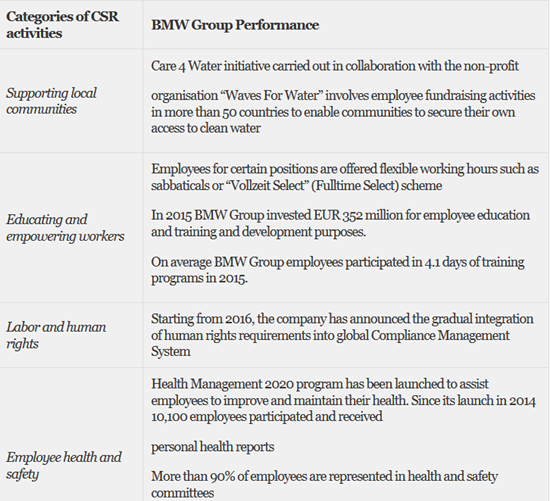
[Source: Bmw, 2014]
The competitive issues faced by BMW in the global luxury car segment can be analyzed with the help of the Porter’s Five Force Analysis. This can be illustrated as follows:
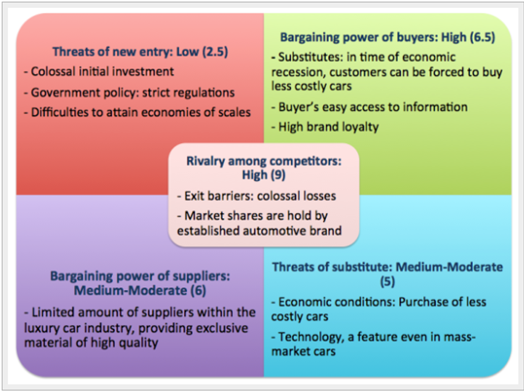
[Source: wordpress, 2015]
The BMW brand is mainly defined by high quality inputs and high marketing budgets and thus the customers by purchasing a BMW car desires to make a statement in the way in which the company tries to ensure i.e. sheer driving pleasure and ultimate driving machine. So this demands from the new entrants’ high budget to brand their products. On the other hand, the industry also demands continuous development of automobiles in the context of quality management, design, technology and production. So it demands high fixed costs on the part of the new entrants. Thus the threat is low or moderate.
Even though BMW operates in order to target the premium segment of market, where the there are few major players but the threat is high since they try outpace with each other through technological innovation and offering as per the specific needs of the customers.
However threat of substitutes in other sense like alternative modes of transportation is low.
The customers of BMW are high-income buyers and they are price insensitive but demand high quality and they mainly purchase BMW vehicles for its perceived quality and high quality of after sales service (wordpress, 2015).
However, there exists possibility that customers might approach other competitors for the similar models and it also does not involve much cost. Thus bargaining power of buyers is moderate.
The production of BMW vehicles require high quality inputs and it can be fulfilled by only few suppliers and thus the company depends upon only few of the suppliers for consistent quality of resources and thus the bargaining power of suppliers is high.
The industry is captured by the players like BMW, Mercedes Benz and Audi and thus there exist cut throat competition in the race of becoming the leader in the world’s luxury car segment. Moreover the exit barriers are also high since each company holds string long term commitments to their customers and this mainly because of the long product life cycle of their products (wordpress, 2015). The customers demand long term customer service and thus it becomes difficult on the part of the companies to easily exit the market.
Moreover, analyzing the automotive industry, it is said that there are various players that pose competition to each other and the market is highly saturated with national, international and local manufacturers. The competitive landscape can be illustrated with the help of the following figure:
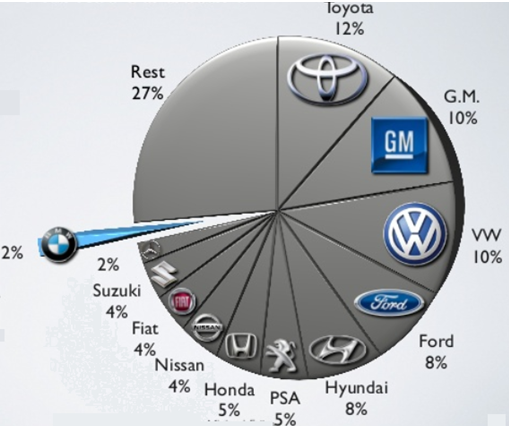
[Source: Johnson et al., 2011]
However, BMW faces direct competition from brands like Lexus, Audi, Mercedes-Benz and Porsche. Again it has also been observed that BMW in the luxury car sales moved down to the third position. The global sales of BMW rose by 7.5% in January 2016 which is behind the 20% leap of Mercedes Benz. On the other Audi experienced the slowest growth i.e. of 4% and Volkswagen outsold BMW with 143,150 vehicles this year (Automotive News, 2016).
The competitive strategy of BMW can be illustrated with the help of the Resource-Based View since it facilitates in identifying the distinctiveness of BMW’s superior performance and competitive advantage in generating unique creations of products and services and thus earn high profits.
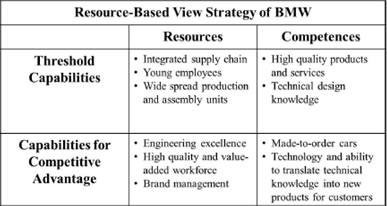
[Source: Johnson et al., 2011]
Again the operations of the automobile companies like BMW are highly influenced by the government regulations around the world. The regulations regarding the safety, end of life disposal and emissions requirements tends to shape the product development and the labor regulations also makes a significant impact on the production standards. The trade and financial regulations affects the flow of cars from factories to markets and also on the decisions regarding where to locate the manufacturing plant and the location of the suppliers (The Financial Express, 2015). The technological advances in the context of the autonomous driving have also influenced the companies to the extent to which the government has regulated these technologies in areas like choosing or encouraging the use of technologies through incentives and subsidies. The regulations in the context of car sharing and ride sharing models have also made a significant impact on the profit and sales and production of the models.
Analyzing the segmenting, targeting and positioning issues of BMW, it can be said that BMW, strives towards adopting the mono-segment type of positioning and thus the company emphasizes upon appealing to a single customer segment (Evans & Berman, 2009). So it can be said that the product portfolio of BMW mainly includes the expensive vehicles at a premium level and thus targets only the premium segment of the market. The product portfolio of the company does not consist of budget vehicles and thus it fails in targeting the individuals and the households who are characterized with smaller budgets.
Segmentation can be illustrated with the help of the following table:
| Type of segmentation | Criteria | BMW target Segment |
| Geographic | Region | Domestic and international |
| Density | Both rural and urban | |
| Demographic | Age group | 20 years to 65 years |
| Gender | Male and female | |
| Life cycle stage | Bachelor, newly married, couples, full nest, empty nest and solitary survivor | |
| Income | High income group | |
| Occupation | Executives and professionals | |
| Behavioral | Degree of loyalty | Hard core and soft core loyal and also switchers |
|
| Benefits sought | Reliability, Speed, quality, luxury, comfort and sense of achievement and status |
|
| Personality | Ambitious and determined |
| Psychographic | Social Class | Upper Middle class and Upper class and premium customers |
BMW strives towards adopting the concentrated targeting strategy and this is mainly because of the fact that the products of the company are premium products and are targeted towards the premium customers (de Chernatony and Daniels, 2008). The company by offering premium products and services to its mono-segment market facilitates them with a sense of achievement, luxury and status in the society.
BMW emphasizes upon positioning its brand as not just a particular image, rather it positions itself in a manner in which customers can related themselves with the brand that is perceived as more valuable than any other product can offer them. However on the other hand, BMW also positions itself as social responsible and innovative company that makes an effective use of the advancements in technology to not only facilitate the customers with unique driving experience but also reduce its impact on the environment in which it is operating (Simms and Trott, 2007). Thus BMW is positioned as a brand that is capable of offering “Sheer driving experience and ultimate driving machine”.
Thus from the above discussions, it is observed that BMW operates in highly competitive market, however the company has been successful in creating and developing unique image of its brand in the minds of the customers and this is key to its success. However marketing strategies play a major role in its endeavor to achieve its goals.
Automotive News. (2016). BMW drops to 3rd place in global luxury sales race during January. [online] Available at: http://www.autonews.com/article/20160210/GLOBAL/160219996/bmw-drops-to-3rd-place-in-global-luxury-sales-race-during-january [Accessed 14 Aug. 2016].
Bmw. (2014). BMW automobiles : BMW AG website: Company and its Marketing Operations. [online] Available at: http://www.bmw.com [Accessed 14 Aug. 2016].
de Chernatony, L. and Daniels, K. (2008). Developing a more effective brand positioning. J Brand Manag, 1(6), pp.373-379.
Engel, J., Blackwell, R. & Miniard, P. (2007), Consumer Behavior (6th ed.), Chicago: The DrydenPress.
Engel, J., Blackwell, R. & Miniard, P. (2010), Consumer Behavior, (8th ed.), Chicago: The DrydenPress.
Evans, J. R. & Berman, B. (2009), Principles of Marketing, (2nd ed.). New York: Macmillan
Gregburns (2011), GM CEO reveals new customer-focused strategy, http://blog.autopartsway.com/?p=299 [Accessed: 14 Aug 2016].
Johansson-Stenman, O. and Martinsson, P. (2006). Honestly, why are you driving a BMW?. Journal of Economic Behavior & Organization, 60(2), pp.129-146.
Johnson, G., Scholes, K., Johnson, G. and Whittington, R. (2011), Exploring strategy. Harlow: Financial Times Prentice Hall.
Karunakaran, K. (2008). Marketing management. Mumbai [India]: Himalaya Pub. House.
Kotler, P. and Armstrong, G. (2006). Principles of marketing. Upper Saddle River, N.J.: Pearson Prentice Hall.
Moschis, G. (2006). Marketing strategies for the mature market. Westport, Conn.: Quorum Books.
Sheehan, B. (2011). Marketing management. Lausanne, Switzerland: AVA Pub.
Simms, C. and Trott, P. (2007). An analysis of the repositioning of the “BMW Mini” brand. Journal of Product & Brand Management, 16(5), pp.297-309.
The Financial Express. (2015). Priorities of global automotive industry - The Financial Express. [online] Available at: http://www.financialexpress.com/industry/automobiles/future-priorities-of-global-automotive-industry/148897/ [Accessed 14 Aug. 2016].
Wänke, M., Bohner, G. and Jurkowitsch, A. (2007). There Are Many Reasons to Drive a BMW: Does Imagined Ease of Argument Generation Influence Attitudes?. J CONSUM RES, 24(2), pp.170-178.
wordpress. (2015). BMW: Industry Rivalry Analysis and Porter's Five Force Analysis. [online] Available at: http://bmvsmb.wordpress.com [Accessed 14 Aug. 2016].
MyAssignmenthelp.co.uk is a name in assignment writing services that students trust. We offer our assignment writing services for a wide variety of assignment including essays, dissertations, case studies and more. Students can place their order with us anytime as we function 24x7, and get their copies at unbeatable prices. We guarantee that all of our solutions are plagiarism-free.
Upload your Assignment and improve Your Grade
Boost Grades